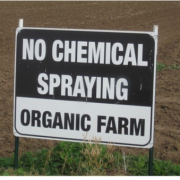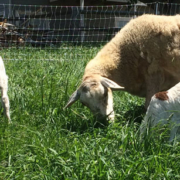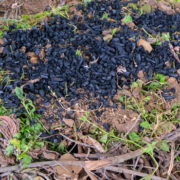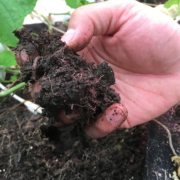Living Mulch Cover Cropping for Gardens and Small Farms: Managing an “organic matter” system
 Print This Post
Print This Post
By Lee Rinehart, NCAT Agriculture Specialist
I’m sure farmers have been using living mulches for ages. But there’s nothing like the feeling when your own light bulb switches on and something old is illuminated. Lincoln Fishman was the guy who did this for me. Let me introduce you. Lincoln is an organic farmer in Massachusetts with whom my colleague Eric Fuchs-Stengel has been working lately. They are documenting Lincoln’s living cover crop system, where he undersows Dutch white clover into vegetables after the last cultivation in July. He found that undersowing the clover was an amazing way to get the field covered by harvest. He would let the cover crop grow and overwinter and then plow down the following spring for green manure. With this system, he has reduced erosion while still providing the soil-building benefits of covers, though the biomass produced by the clover didn’t provide as much biomass as other common winter cover crops like rye or peas. When he needed added biomass, he experimented with undersowing Dutch white clover into early harvested crops, mowing the post-harvest crop, and then drilling rye into the clover.
But what if you leave the white clover cover crop to continue growing in the second year? Now it becomes a perennial living mulch to direct seed or transplant cash crops into. Clover grows aggressively at the beginning of the season, Lincoln told me, so it’s best to direct seed or transplant vegetables into the clover in late May or after (he’s in Massachusetts), when the clover growth slows and competition is reduced. He does this by mowing the clover as close to transplanting as possible, preferably the day he intends to transplant. The cash crop can get ahead of the clover and by the time the clover spreads and gains altitude, the crop is well established. Periodic mowing keeps it under control and adds a green manure mulch to the crops.
I revisited this idea again when I was talking with Helen Atthowe at the Carolina Farm Stewardship Conference this past November. Helen is a long-time organic farmer who’s farmed in Montana and northern California and, though always an organic grower, has experienced a shift in practices because of her propensity to do on-farm research. Whereas at one time she advocated organic approaches and specific practices to deal with singular issues with pests or crop fertility, she now fosters a system based on ecological farm design.
The foundation of her “organic matter” system is maintaining diversity of crop and ground cover year-round, with living roots as much as possible throughout the year. And it’s focused on growing carbon, which she grows and adds regularly, spaced out throughout the season to take advantage of the slow release of carbon to feed soil microbes. Note that this system doesn’t pay exclusive attention to nitrogen as is wanted by many of us farmers and gardeners. Instead, she builds habitat for soil microorganisms to do the good work of nutrient cycling, a natural process that not only delivers fertility to crops but fosters resilience to pests and diseases. The wild habitat that is created by the living mulch between crop rows and by undisturbed sequentially blooming perennial plants provides a place for microbes and beneficial insects to thrive as close to the crops as possible.
In my last blog, I wrote about using light spring tillage to incorporate winter cover crops for summer fertility and suggested that a winter-killed oat and pea cover might be good for getting summer crops in earlier without waiting for green manure decomposition. I still think that’s a great idea and will use this technique when appropriate. But I am beginning to feel that annual winter cover cropping and twice a year tillage (to incorporate the cover crop in the spring, and to terminate and plant the cover crop in the fall) is too much tillage for me.
Instead, I can terminate my winter cover and lightly plow it in this spring, put out my transplants, and undersow white clover. At least on one bed this year to give me a chance to learn something. I’ll follow Helen’s advice and mow the clover throughout the season and throw the residue onto the crop beds as mulch. I’ll have about two or three years of perennial cover with light strip tilling for crop establishment. I will terminate the clover in year three or so in the fall, when I’ll till again and plant my winter annual mix – this is crucial, I believe, because the winter annual cover crop will add loads of biomass to the garden beds… much more than the white clover living mulch. Then once again, a spring plow down and re-establishment of the white clover after transplanting. The cycle goes on, and I have reduced full bed tillage from twice a year to a mere four times in eight years.
I like this system because it focuses on carbon accumulation and nutrient cycling rather than on nitrogen. This makes me think of the adage “if you build it, they will come.” Also, Helen’s research has shown that with mulching and strip tillage you get more microbial diversity and higher microbial activity. So, my cover crop and tillage journey continues to evolve. I am looking forward to next season and the soil test results I will receive from the different treatments on my garden beds. Until then, you can learn more about living mulches by exploring the resources listed below. And reach out if you have anything to share about your own journey, and what your garden has been saying to you. Send me a note at lee@ncat.org to share your ideas.
Related ATTRA Resources:
Practicing Resurrection: Using Green Manures on a Small Semi-Urban Homestead
Toolkit: How to Reduce Synthetic Fertilizer Use
Other Resources:
Growing Vegetables in a Perennial Clover Living Mulch: Part 1
Book Review: The Ecological Farm by Helen Atthowe
This blog is produced by the National Center for Appropriate Technology through the ATTRA Sustainable Agriculture program, under a cooperative agreement with USDA Rural Development. ATTRA.NCAT.ORG.








 Canva Pro
Canva Pro


